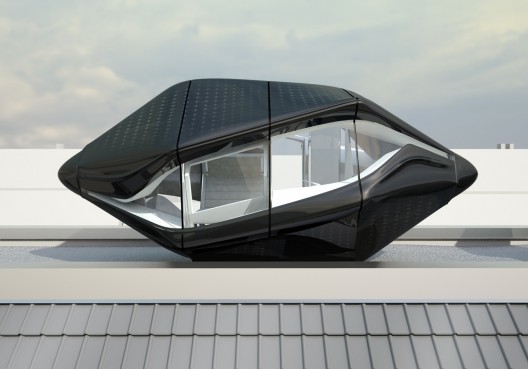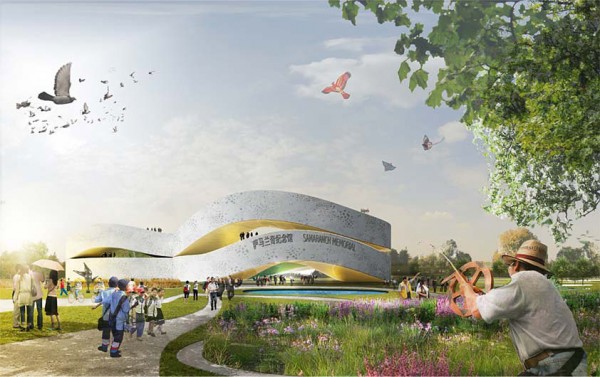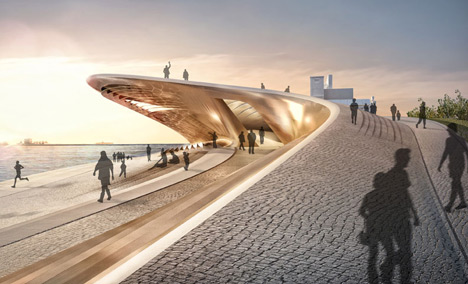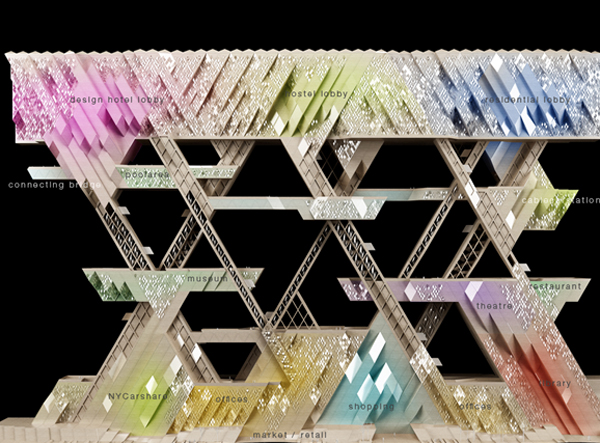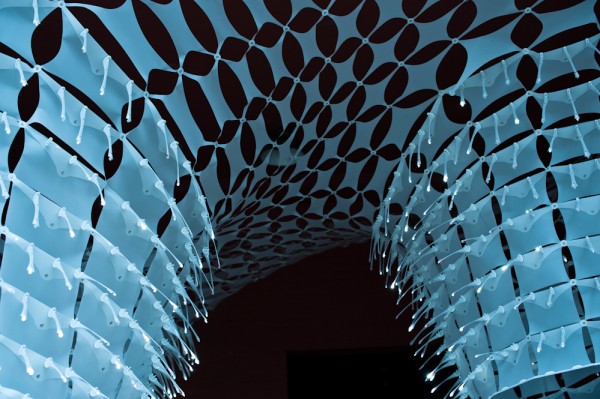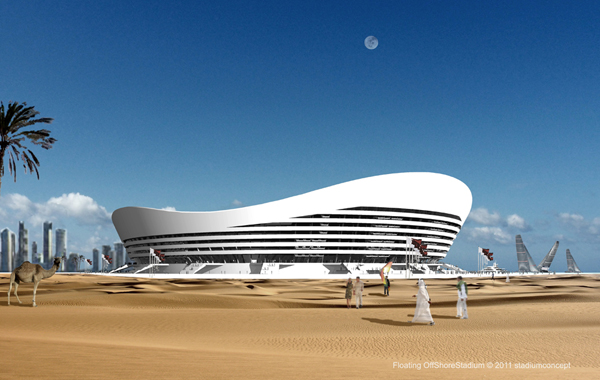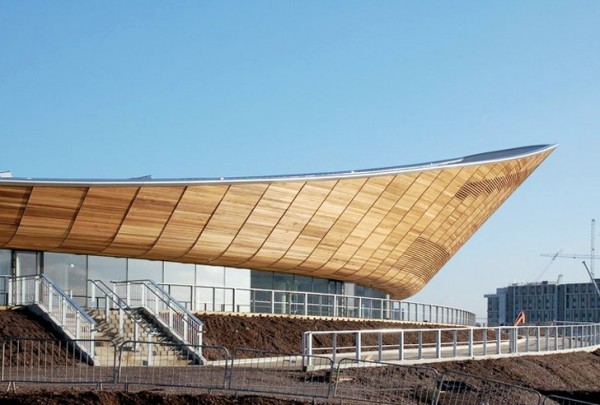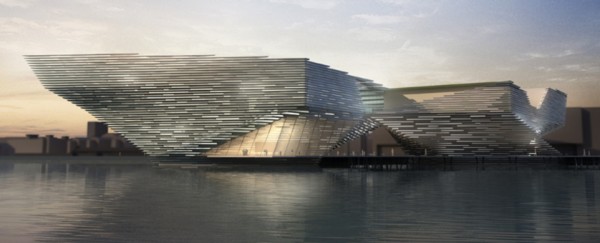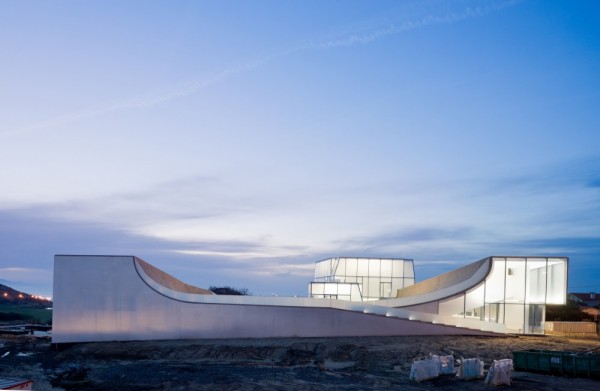The Living Roof by NAU is a living environment boiled down to its most essential elements: Arefuge to recover, plan excursions into the city, or simply stare into the stars. Offering you the essence of the city, it condenses all the functions of daily life into a compact and self- sustaining capsule, intended for urban rooftops, but ready to be airlifted into the savanna at short notice. The minimal interior allows for concentrated thought and recuperation, while the highly efficient enclosure helps resolve one of the paradoxes of modern life: the contemporary citizen seeks mobility, but also wants to tread softly on the environment. For just this sort of traveler, NAU has designed the Living Roof, the first short-term housing unit to produce more energy than it consumes. Read the rest of this entry »
Living Roof for the Contemporary City Dweller / NAU
Tianjin-Samaranch Memorial Olympic Museum / Holm Architecture Office
The five interlocking rings of the Olympic symbol serves as the foundation for the 25,000 square meter (250,000 square foot) building design by Holm Architecture Office. By re-arranging the rings and varying the scale, the HAO design creates a museum consisting of two rings above ground with three sunken courtyards.
The two main rings serve as counterparts in the story of the life of Juan Antonio Samaranch. The first ring invites visitors in through a public courtyard, lifting them onto a circular ramp. This ring will house exhibits that speak to the legacy of Juan Antonio Samaranch’s work with the Olympic Committee and the impact it has had on China and the world. The second ring encloses a garden and focuses on the life and work of Juan Antonio Samaranch, serving as a memorial to his achievements.
Together the two rings create a continuous loop taking the visitor through both the exhibition and memorial areas. The building design incorporates green technologies, from the installation of energy-producing solar cells on the building’s roof to climate control through geothermal heating and cooling. Read the rest of this entry »
EDP Foundation Cultural Centre in Lisbon / Amanda Levete Architects
The EDP Foundation Cultural Centre in Lisbon is a project about water, light, reflections and people – a building that captures the essence of the unique riverside site and the extraordinary southern light of Lisbon.
The site is of strategic importance. Acting as the gateway to the culturally rich area of Ajuda / Belém, the building will be a magnet, drawing people from the heart of the city to the panoramic views along the Tagus estuary. The currently neglected riverfront area will be activated, and the cultural centre will become one of Lisbon’s leading destinations.
This project is also about democracy. It is a building for the people – for the people of Lisbon, for cultural visitors and for tourists. It is a building for culture and leisure that defies the boundaries between public space and building. A simple and organic gesture creates a topographic form that blends into landscape making a fluid and natural relationship between inside and outside – people move over as well as through the building.
The building creates an attractive landscape, stepping down into the river Tagus. At high tide the steps are covered with water creating a constantly changing space that converses with the tide and the reflections from the water. The reflections play with the overhanging façade to give unexpected lighting effects both inside and out, capturing and magnifying the unique light qualities of this south facing site. An area of welcome shade is naturally created by the cantilevered structure. Read the rest of this entry »
The NY-BILLBOARD by Prechteck
Despite unique identities, geographic spread and differing economies, cities all over the world are being challenged by the same mega trends. With more than 60% of the world population predicted to live in cities by 2030 we are asked to develop sustainable strategies for the future. There is no doubt that the density of cities will increase and therefor the cities fabric will grow vertically. But with reaching a certain height, towers are facing problems:
Height is isolating: towers are monuments elevating the cities population form its urban grid. At the height of towers, ones experience becomes isolated from the public and urban conditions.
Height is dangerous: exiting a highrise in case of an emergency (natural or manmade catastrophes for instance) is facing serious difficulties.
Height is insufficient: when it comes to getting down by elevator 50+ floors for an hour-long lunchbreak and going the same way back later on, towers get inefficient with a certain height.
The NY-BILLBOARD
The proposal designed by Prechteck seeks for a way to add a new horizontal layer to Manhattan. An elevated link between towers, separated from traffic and noise, filled with public functions, bicycle lanes and walkways. The groundarea covered by towers will be given back to the public by integrating its roofs to the grid of linking walkways, elevated gardens and public facilities and, as a unique aspect, it introduces public life into the skyline of Manhattan. NY-BILLBOARD is an accentuation of this new layer on a strategic important site. Read the rest of this entry »
POLYP.lux by SOFTlab a Flash:Light:2011, Festival of Ideas for the New City installation
SOFTlab produced a hanging installation for the entrance to School Nite, an exhibition of site-specific installations, performances, and discussions. The installation was curated by Nuit Blanche New York as part of Flash:Light 2011 along with the Festival of Ideas for the New City sponsored by the New Museum.
The installation was in the entrance of St. Patrick’s Catholic School at the corner of Prince and Mott Streets in NYC. The form was generated through a gravity driven process and then prepped for production. The surface contains more than 1400 battery powered LEDs. The piece was designed to light up the entrance for the night time event. The main formal expressions of the installation are the hanging pieces that flicker and blow in the wind, with the intention of slowing down traffic through experience and effect rather than typical barriers. Visitors are meant to co-mingle and interact with the piece, not unlike a clown fish and the sea anemone. Read the rest of this entry »
Floating Off-Shore Stadium for FIFA World Cup 2022 in Qatar
Developed by the german architects stadiumconcept for the FIFA World Cup 2022 the Floating Off-Shore Stadium represents an extraordinary and ambitious concept – it can be regarded being the most sensational stadium solution since the emergence of modern sport arenas. The Floating OffShore Stadium is a swimming construction that can be relocated to seaside venues across the oceans.
Due to its global mobility it can be utilised by far more effectively as traditional stadiums as it could serve for more than one, for example, FIFA tournament. By shipping to the next venue this concept offers a visionary way to maximise the utilisation of long-term investments without sacrificing the efficient use of energy resources – the Floating OffShore Stadium is eco-efficiently powered by a blend of hybrid energies such as water, wind and solar power.
Its mobility and multi-decade utilisation and overall eco-efficiency bring significant advantages over traditional, on-shore stadium concepts. This concept consequently offers new ways for enjoying permanent financial profits for investors over a long period of time and public stakeholders alike – but at least it is created to enjoy the people around the world. Read the rest of this entry »
GSI Tower in Cancun / Sanzpont Arquitectura
GSI Tower is designed by Sanzpont Arquitectura, and will be located in Cancun, Mexico. This 20-storey building will house a shopping mall, hotel and offices, and consists of 2 vertical bodies that meet at the top by 2 habitable bridges with an interior garden to form a large frame of the natural landscape.
The Building is protected from the sun on the western face with a ventilated façade made of alucobond in the form of fish scales, indirect natural light is filtered inside between the horizontal louvers of its perimeter. In the eastern façade, the building skin is designed with a set of serigraph, sandblasted and transparent glass that take advantage of the natural views of the Golf Course and the Caribbean Sea. It gives the city an elevated public square that generates an urban green balcony. As an added value, the building allows the public to continue to rise even more, because it has a restaurant lounge at the top level. With all this, the vertical infrastructure integrates with the city life and urban environment. Read the rest of this entry »
The 2012 Olympic Velodrome in London won Building of the Year Award / Hopkins Architects
The Olympic Velodrome designed by Hopkins Architects, one of the four permanent venues on the Olympic Park and designed for the indoor track cycling events at the London 2012 Olympic and Paralympic Games won the Architects’ Journal Building of the Year award. The facility was unilaterally agreed upon by judges for the prize due to its “near perfect synthesis of form and function”, as described by jury member Patrik Schumacher of Zaha Hadid Architects.
The jury, which also comprised Frank Duffy (DEGW) and Christine Murray (AJ editor), were particularly impressed by the beauty of the cedar cladding, the ingenious lightweight double cable-net roof, the dominance of natural light and the Velodrome’s beauty in section.
Last year, Hopkins’ Kroon Hall at Yale University received the Building of the Year award. Read the rest of this entry »
Museum of Art and Design at Dundee, Scotland / Kengo Kuma
The stunning design by Japanese-based architects Kengo Kuma and Associates was selected by an international jury as the choice for the V&A at Dundee following an extensive process of consultation and evaluation, including meeting with all the architects and their teams, visiting their existing buildings, and establishing the feasibility of the project to meet the tight timescales and budget.
The public’s views were given serious attention in the process after thousands of individuals completed questionnaires and commented on the proposals. 15,000-plus people visited the exhibition and many more viewed it online.
Reaction to the six shortlisted proposals was not confined to the world of design but went right back to the man on the street – on the same day that Vogue.com ran an article on Kengo Kuma & Associates, the Dundee United Football Club supporters blog buzzed with positive opinion on the winning design.
The chosen design (which references the V&A at Dundee’s celebrated neighbour, the RRS Discovery) is a striking building that will come to represent Dundee and has the potential to be one of Europe’s most iconic buildings. Once built, the building itself will appear to ‘float’ on the water. Read the rest of this entry »
Museum of Ocean and Turf / Steven Holl Architects and Architect Solange Fabiao
The Museum of Ocean and Turf designed by Steven Holl and Solange Fabiao is ready to open its doors in June 2011.
The building form derives from the spatial concept “under the sky”/“under the sea”. A concave “under the sky” shape forms the character of the main exterior space, the “Place de l’Océan.” The convex structural ceiling forms the “under the sea” exhibition spaces. The building’s spatial qualities are experienced already at the entrance where the lobby and ramps give a broad aerial view of the exhibition areas, as they pass along the dynamic curved surface that is animated by moving image and light.
The precise integration of concept and topography gives the building a unique profile. Towards the ocean, the concave form of the building plaza is extended through the landscape. With slightly cupped edges, the landscape, a mix of field and local vegetation, is a continuation of the building and will host festivals and daily events that are integrated with the museum facilities. Read the rest of this entry »

